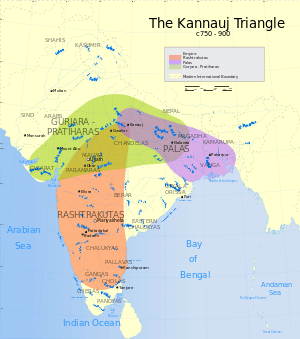Kannauj
| Kannauj Cannodge | |
|---|---|
| city | |
| Nickname(s): Perfume Capital of India; Grasse of the East | |
 Kannauj | |
| Coordinates: 27°04′N 79°55′E / 27.07°N 79.92°ECoordinates: 27°04′N 79°55′E / 27.07°N 79.92°E | |
| Country |
|
| State | Uttar Pradesh |
| District | Kannauj |
| Elevation | 139 m (456 ft) |
| Population (2001) | |
| • Total | 1,656,616 |
| Languages | |
| • Official | Hindi |
| Time zone | IST (UTC+5:30) |
| Website |
www |
Kannauj (Hindi: कन्नौज, Urdu: قنوج, formerly known in English as Cannodge), also spelt Kanauj, is a city, administrative headquarters and a municipal board or Nagar Palika Parishad in Kannauj district in the Indian state of Uttar Pradesh. The city's name is a modern form of the classical name Kanyakubja[1] (The city of the hunchbacked maidens). It was also known as Mahodaya during the time of Mihira Bhoja. Kannauj is an ancient city, in earlier times the capital of the Empire of Harsha under Emperor Harsha. It is said that Kanyakubja Brahmin's are originally from Kannauj. Kannauj is known for the distilling of scents and is a market center for tobacco, perfume, and rose water. It has given its name to a distinct dialect of the Hindi language known as Kanauji, which has two different codes or registers.
The Kannauj Triangle
Kannuaj remained a focal point for the three powerful dynasties, namely the Gurjara Pratiharas, Palas and Rashtrakutas, between the 8th and 10th centuries. The conflict between the three dynasties has been referred to as the Tripartite struggle by many historians.[2][3]
There were initial struggles but ultimately the Gurjara Pratiharas succeeded in retaining the city.[2] The Gurjara-Pratiharas ruled Avanti (based at Ujjain), which was bounded to the South by the Rashtrakuta Empire, and the Pala dynasty to the East. The Tripartite Struggle began with the defeat of Indrayudh at the hands of Gurjara-Pratihara ruler Vatsaraja.[2] The Pala ruler Dharampala was also keen to establish his authority at Kannauj, giving rise to a struggle between Vatsaraja and Dharampala. Dharampala was however defeated.[4] Taking advantage of the chaos, the Rastrakuta ruler Dhruva surged northwards, defeated Vatsaraja, and took Kannauj for himself, completing the furthest northern expansion by a South Indian ruler.[3][5]
When the Rashtrakuta ruler advanced back to south, Dharampala was left in control of Kannauj for some time. The struggle between the two northern dynasties continued: the Pala Chakrayudh was defeated by the Pratihara Nagabhata II, and Kannauj was again occupied by the Gurjara Pratiharas. Dharampala tried to take control of Kannauj but was defeated badly at Moongher by the Gurjara Pratiharas.[2] However, Nagabhata II was in turn soon defeated by the Rashtrakuta Govinda III, who had initiated a second northern surge. An inscription states that Chakrayudh and Dharampala invited Govinda III to war against the Gurjara Pratiharas, but Dharampala and Chakrayudh both submitted to the Govinda III, in order to win his sympathy. After this defeat Pratihara power degenarated for some time. After the death of Dharampala, Nagabhata II regained hold over Kannuaj and made it the capital of the Gurjara Pratihara Empire. During this period the Rashtrakutas were facing some internal conflicts, and so they, as well as the Palas, did not contest this.[2] Thus Gurjara Pratiharas became the greatest power in Northern India after occupying Kannauj.[2]
Sultan Mahmud of Ghaznavi captured Kanauj in 1018. Chandradeva founded the Gahadvala dynasty with its capital at Kanauj around 1090. His grandson Govindachandra "raised Kanauj to unprecedented glory." Muhammad Ghori advanced against the city, and in the Battle of Chandwar of 1193, killed Jayachandra. The "glory of Imperial Kanauj" ended with Iltutmish's conquest.[6]:21,32–33
Geography
Kannauj is located at 27°04′N 79°55′E / 27.07°N 79.92°E.[7] It has an average elevation of 139 metres (456 feet).
Demographics
As of 2001 India census,[8] Kannauj had a population of 71,530. Males constitute 53% of the population and females 47%. Kannauj has an average literacy rate of 58%, lower than the national average of 59.5%: male literacy is 64%, and female literacy is 52%. In Kannauj, 15% of the population is under 6 years of age.
Colleges
Medical College
Government Medical College, Kannauj is a government medical college located in Tirwa of Kannauj, Uttar Pradesh, India. It is affiliated to King George's Medical University, Lucknow. In 2012, the institute become recognized for 100 M.B.B.S. seats by Medical Council of India (MCI).
Engineering College
Government Engineering College, Kannauj is a government engineering college in Kannauj. It is a constituent college of Dr. A.P.J. Abdul Kalam Technical University (formerly Uttar Pradesh Technical University) in Lucknow, and has its temporary campus at Harcourt Butler Technical University in Kanpur.
Sister cities
See also
References
- ↑ Rama Shankar Tripathi (1989). History of Kanauj: To the Moslem Conquest. Motilal Banarsidass Publ. p. 2. ISBN 978-81-208-0404-3, ISBN 978-81-208-0404-3.
- 1 2 3 4 5 6 Pratiyogita Darpan. Upkar Prakashan. p. 9.
- 1 2 R.C. Majumdar (1994). Ancient India. Motilal Banarsidass Publ. pp. 282–285. ISBN 978-81-208-0436-4, ISBN 978-81-208-0436-4.
- ↑ Kumar Sundram (2007). Compendium General Knowledge. Upkar Prakashan. p. 195. ISBN 978-81-7482-181-2, ISBN 978-81-7482-181-2.
- ↑ Pratiyogita Darpan. Upkar Prakashan.
- ↑ Sen, S.N., 2013, A Textbook of Medieval Indian History, Delhi: Primus Books, ISBN 9789380607344
- ↑ Falling Rain Genomics, Inc – Kannauj
- ↑ "Census of India 2001: Data from the 2001 Census, including cities, villages and towns (Provisional)". Census Commission of India. Archived from the original on 2004-06-16. Retrieved 2008-11-01.
- ↑ http://www.tornosindia.com/in-the-offing-perfume-park-museum-and-twin-cit/
- ↑ http://www.samacharplus.com/index.php/en/cities/36-up-uttarakhand/lucknow/5085-twin-city-agreement-between-kannauj-and-grasse-to-be-signed-by-up-govt
- ↑ http://m.navbharattimes.indiatimes.com/business/business-news/kannauj-grasse-will-sign-the-twin-city-agreement/articleshow/47413270.cms
http://jnvkannauj.org/history.php
External links
- District Kannauj Website.
- History of Kanauj: To the Moslem Conquest By Rama Shankar Tripathi
- PincodeDirectory.net
-
 This article incorporates text from a publication now in the public domain: Chisholm, Hugh, ed. (1911). "article name needed". Encyclopædia Britannica (11th ed.). Cambridge University Press.
This article incorporates text from a publication now in the public domain: Chisholm, Hugh, ed. (1911). "article name needed". Encyclopædia Britannica (11th ed.). Cambridge University Press.
